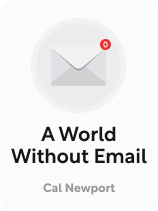

This article is an excerpt from the Shortform book guide to "A World Without Email" by Cal Newport. Shortform has the world's best summaries and analyses of books you should be reading.
Like this article? Sign up for a free trial here.
What are the major problems with emails? Is checking your email a bad thing?
Checking your email isn’t necessarily a bad thing, but if it’s taking up most of your day, it might be distracting you from important work. Cal Newport’s book A World Without Email claims that a habit of constantly checking emails causes a hyperactive hive mind workflow (HHMW)—which can hurt you and your work.
Let’s look at the four problems with emails, both for companies and individuals.
Downside #1: Knowledge Workers Constantly Multitask and Are Thus Less Productive
The first problem with emails is that workers are almost always multitasking: performing their main work function while also responding to messages, asserts Newport. Such multitasking isn’t productive because it takes significant cognitive resources and energy to switch between tasks, which reduces performance on both. It also takes longer to complete two tasks at once than to complete two tasks in succession. This makes multitasking inefficient for the company, which isn’t getting the best output from workers.
(Shortform note: In The One Thing, Gary Keller elaborates on what happens in your brain when you multitask: When you seemingly do two things at once—hold a conversation and shoot off an email, for instance—you shift focus between them, moving one task to the foreground and the other to the background of your mind. This focus shift saps your cognitive energy. Keller also quantifies the cost of constant multitasking: Employees spend a third of their days recovering from interruptions, and cognitive switching can cause a task to take 25% to 100% longer than if you performed that task without interruption.)
Downside #2: Knowledge Workers Do More Work Than Necessary
Because it’s so easy to email, colleagues are more likely to email a request to a knowledge worker than to figure out and handle the problem themselves, writes Newport. The result of this is that the recipient must spend time dealing with requests that could have been otherwise handled.
(Shortform note: In the same way technology makes it easy to quickly send emails that can cause frustration or excess work for the recipient, technology also makes it easy to quickly send multiple text messages that can be irritating and time-consuming for the recipient. Some texters express a single idea or piece of information across many texts, forcing the recipient to stay on their messenger screen, awaiting the end.)
Downside #3: Written Communication Can Be Ambiguous
Another problem with emails is that written communication fails to convey all the nonverbal information—tone, mode of speech, body language—that’s conveyed through in-person interactions, making it a relatively poor method of communication, claims Newport. This means you must write many emails to communicate what could be said verbally in moments. Additionally, you might worry about whether your meaning comes across appropriately in email or about a message that seems to convey anger (but doesn’t really).
(Shortform note: In Difficult Conversations, the authors provide tips on how to both receive and respond to written digital communication to minimize upsetting ambiguity and time spent on them. When receiving an ambiguous message, they advise always assuming the writer had good rather than bad intentions and to schedule an in-person meeting rather than responding via email if you still feel unsure of their meaning. When sending a message, be as explicit as possible so your recipient doesn’t have to spend time parsing your email or worrying about how you feel.)
Downside #4: Workers Are Miserable
The final implication of the HHMW stems from the above implications: Reduced productivity, excess work, and impoverished communication make workers miserable, concludes Newport. (Shortform note: A workforce of miserable employees hurts companies: Some statistics show that miserable workers cause a loss in productivity of $450 billion to $550 billion per year in the US. Conversely, happy workers are up to 20% more productive than unhappy ones.)

———End of Preview———
Like what you just read? Read the rest of the world's best book summary and analysis of Cal Newport's "A World Without Email" at Shortform.
Here's what you'll find in our full A World Without Email summary:
- How email makes knowledge workers less productive and more unhappy
- How to improve the channels through which people communicate
- Why you should implement protocols to reduce unnecessary work






